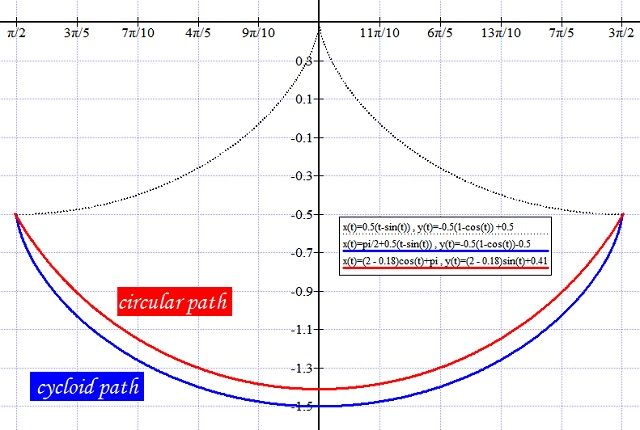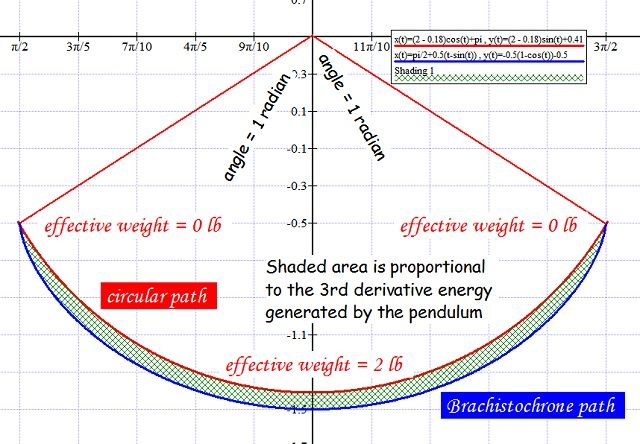http://www.rarenergia.com.br
Another claim to a working device...
Moderator: scott
-
Furcurequs
- Devotee

- Posts: 1605
- Joined: Sat Mar 17, 2012 4:50 am
re: Another claim to a working device...
I don't believe in conspiracies!
I prefer working alone.
I prefer working alone.
re: Another claim to a working device...
How many times can I cut a bit off, reweld it on in a different position, add another weight over there....... stalling or hoping. It is obvious they don't know what they are doing. Any investors would be kicking themselves at the moment examining the progression and modification of this mechanism.
Charletans.
Charletans.
-
justsomeone
- Addict

- Posts: 2097
- Joined: Tue Dec 30, 2008 5:21 pm
re: Another claim to a working device...
Were they asking for investors?
. I can assure the reader that there is something special behind the stork's bills.
Re: re: Another claim to a working device...
There's every reason to suppose that they don't need any investors since their father is a multi-millionaire.Tarsier79 wrote:How many times can I cut a bit off, reweld it on in a different position, add another weight over there....... stalling or hoping. It is obvious they don't know what they are doing. Any investors would be kicking themselves at the moment examining the progression and modification of this mechanism.
Charlatans.
Let's be optimistic and assume that the modifications are intended to optimise the performance of the device.
Who is she that cometh forth as the morning rising, fair as the moon, bright as the sun, terribilis ut castrorum acies ordinata?
- Jim Williams
- Aficionado

- Posts: 734
- Joined: Thu Jul 13, 2006 7:08 pm
- Location: San Francisco
re: Another claim to a working device...
It might be better to consider it an example of what money cannot buy. It reminds me of people who bother to obtain a patent on a device that is just not going to work. For what purpose? Other than becoming better known for something that fails to deliver.Let's be optimistic and assume that the modifications are intended to optimise the performance of the device.
Make up reality
re: Another claim to a working device...
Hi,i think it is money well spent ,the event shows a attempt and heightens awareness to the potential of the principle to the general pop,which has to be good,keep it coming guys spend millions whats it for.
Only by making mistakes can you truly learn
- Jim Williams
- Aficionado

- Posts: 734
- Joined: Thu Jul 13, 2006 7:08 pm
- Location: San Francisco
re: Another claim to a working device...
I learned as a kid to never ski faster than I could afford to fall. Although I concede I can't tell by the photos, his machine looks like other devices I've seen that didn't work.
I think the person behind it has shown an abundance of courage in his pursuit, and hats off to him. I just hope he has prepared for what a number of people here have already experienced in similar attempts.
I think the person behind it has shown an abundance of courage in his pursuit, and hats off to him. I just hope he has prepared for what a number of people here have already experienced in similar attempts.
Make up reality
Even if they do succeed, they are not the first.
Raymond Head is the Faraday of the 21st century.
http://www.youtube.com/watch?v=gC6Qlj1Mbo8
Raymond Head is the Faraday of the 21st century.
http://www.youtube.com/watch?v=gC6Qlj1Mbo8
re: Another claim to a working device...


Who is she that cometh forth as the morning rising, fair as the moon, bright as the sun, terribilis ut castrorum acies ordinata?
re: Another claim to a working device...

The generation of the higher derivative energy can best be illustrated with
a coin rolling demonstration.
If you roll a seven sided 50p coin (the large pre-1997 are best) along a
smooth horizontal plane the coin will initially jump up and down with a
rattling noise. This is because though the diameter of the coin is constant
its centre of mass is not generally at the half diameter point. When the
coin is rolling fast enough the vertical oscillation of the mass centre is
sufficient to lift the coil free of the horizontal surface. The impact
when if falls back causes the rattling.
As the speed decreases there come a point where the rattling suddenly
ceases and the coin rolls smoothly.
This is the point where the vertical oscillation of the mass centre is
insufficient to lift the coin. It only varies the force applied by the
coin to the horizontal plane.
Who is she that cometh forth as the morning rising, fair as the moon, bright as the sun, terribilis ut castrorum acies ordinata?
re: Another claim to a working device...
http://www.youtube.com/watch?v=gC6Qlj1Mbo8
The most interesting comments on that page are those by addicted2wingboats.
First he says,
addicted2wingboats 1 year ago
This doesn't work the way it is explained. Firstly it isn't lifting 74lb, because
the pendulum weighs 46lb? it is only lifting about 28lb. But really it isn't
lifting anything. The weight "lifts" about an inch (taking energy from the
pendulum), then it "falls" the same distance, giving energy back to the
pendulum. If the weight had a ratchet, so that when it lifts it's unable to fall
back down, the pendulum would quickly lose energy and you would have to
push harder.
then,
addicted2wingboats 1 year ago
You could achieve the same result by hanging the weight from a long spring,
and gently pushing down on it in rhythm. It would eventually reach the same
height. If you measured the small force of each push and totaled them, the
total would equal the force needed to actually lift the weight the? distance
achieved.
then he has further thoughts on the subject and writes,
addicted2wingboats 1 year ago
There is a slight energy gain because of the cycloidal movement, but is is less
the the friction inherent in the system plus the wind resistance of the
pendulum. Plus? there is always energy lost converting momentum from one
form to another, in this case rotary to linear.
which is correct as far as the cycloid is concerned though I would like to know
how he came to this conclusion. He certainly didn't understand the
implications and I doubt if he realised that he was generating third derivative
energy.
I am trying to contact addicted2wingboats from his YouTube site.
The most interesting comments on that page are those by addicted2wingboats.
First he says,
addicted2wingboats 1 year ago
This doesn't work the way it is explained. Firstly it isn't lifting 74lb, because
the pendulum weighs 46lb? it is only lifting about 28lb. But really it isn't
lifting anything. The weight "lifts" about an inch (taking energy from the
pendulum), then it "falls" the same distance, giving energy back to the
pendulum. If the weight had a ratchet, so that when it lifts it's unable to fall
back down, the pendulum would quickly lose energy and you would have to
push harder.
then,
addicted2wingboats 1 year ago
You could achieve the same result by hanging the weight from a long spring,
and gently pushing down on it in rhythm. It would eventually reach the same
height. If you measured the small force of each push and totaled them, the
total would equal the force needed to actually lift the weight the? distance
achieved.
then he has further thoughts on the subject and writes,
addicted2wingboats 1 year ago
There is a slight energy gain because of the cycloidal movement, but is is less
the the friction inherent in the system plus the wind resistance of the
pendulum. Plus? there is always energy lost converting momentum from one
form to another, in this case rotary to linear.
which is correct as far as the cycloid is concerned though I would like to know
how he came to this conclusion. He certainly didn't understand the
implications and I doubt if he realised that he was generating third derivative
energy.
I am trying to contact addicted2wingboats from his YouTube site.
Who is she that cometh forth as the morning rising, fair as the moon, bright as the sun, terribilis ut castrorum acies ordinata?
re: Another claim to a working device...
Frank.
Whenever you start trying to bamboozle the less mathematical members with your lectures on higher derivatives (admittedly, my mathematical prowess is somewhat limited), I wonder if you truly understand the implications of higher derivatives being in an equation of movement, and why they would be there. Also, according to your mathematical formula of the movement of a cycloid, is it my imagination, or is my lack of seeing a higher derivative in that formula an indication that it does not exist in the cycloid?
How do you know it is correct, and do you have any evidence to support your claim. There is energy transfer in a cycloid, or a cycloid-like shape, due to the movement of the horizontal beam in the milkovic. There has to be a deviation from the circular path, or there is no movement of the counter weight and no work. That energy is also swapped between driver and load, and you say there is gain in that, even though he hasn't shown you why he thinks also. Any claim without evidence, or even a theory as to why it might occur seems to not even be worthy of the term "hypothesis".There is a slight energy gain because of the cycloidal movement, but is is less
the the friction inherent in the system plus the wind resistance of the
pendulum. Plus? there is always energy lost converting momentum from one
form to another, in this case rotary to linear.
which is correct as far as the cycloid is concerned though I would like to know
how he came to this conclusion
Whenever you start trying to bamboozle the less mathematical members with your lectures on higher derivatives (admittedly, my mathematical prowess is somewhat limited), I wonder if you truly understand the implications of higher derivatives being in an equation of movement, and why they would be there. Also, according to your mathematical formula of the movement of a cycloid, is it my imagination, or is my lack of seeing a higher derivative in that formula an indication that it does not exist in the cycloid?
re: Another claim to a working device...

I have modified the second of the previous diagrams since the cycloid shaped curve should really
have been labelled as a brachistochrone, the path that will carry a body while under the action
of constant gravity from one place to another in the least amount of time.
All brachistochrones are cycloids but not all cycloids are brachistochrones.
[I think I didn't bother in the first instance cos I couldn't remember how to spell it. :-( ]
I have also added the effective weights of a 1 lb bob to the diagram at the top and bottom
of the circular arc swing.
Who is she that cometh forth as the morning rising, fair as the moon, bright as the sun, terribilis ut castrorum acies ordinata?
Grimer,
First let me say I prefer locking the pendulum after each half swing. After the swing, the pendulum is caught in a catch, and the counter weight takes over lifting the pendulum back to it's initial position, then the pendulum is released and the process repeats itself. Doing this brings out the problem with the 2SO as I will try to describe below.
In my tests with a standard Milkovic style 2SO, the pendulum never returned to the same drop height relative to the pendulum pivot point, and I believe it is because the pivot point accelerates downward, due to the CF of the swinging pendulum bob.
This led me to performing a simple pendulum drop experiment in an elevator. The pendulum always returned to the drop height even though the elevator was moving down. I have to assume it was due to the elevator moving downward at a "constant" velocity. If we can find a replacement for the main bar (perhaps some type of linkage) so the pivot point can move downwards but not accelerate, then the bob would return to the initial drop height, relative to the pivot point, then as I mentioned above, the pendulum would be caught at the end of the swing, and the counter weight would lift the pendulum back to it's initial position.
First let me say I prefer locking the pendulum after each half swing. After the swing, the pendulum is caught in a catch, and the counter weight takes over lifting the pendulum back to it's initial position, then the pendulum is released and the process repeats itself. Doing this brings out the problem with the 2SO as I will try to describe below.
In my tests with a standard Milkovic style 2SO, the pendulum never returned to the same drop height relative to the pendulum pivot point, and I believe it is because the pivot point accelerates downward, due to the CF of the swinging pendulum bob.
This led me to performing a simple pendulum drop experiment in an elevator. The pendulum always returned to the drop height even though the elevator was moving down. I have to assume it was due to the elevator moving downward at a "constant" velocity. If we can find a replacement for the main bar (perhaps some type of linkage) so the pivot point can move downwards but not accelerate, then the bob would return to the initial drop height, relative to the pivot point, then as I mentioned above, the pendulum would be caught at the end of the swing, and the counter weight would lift the pendulum back to it's initial position.